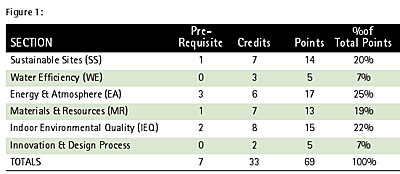
Lead, follow or get out of the way
The LEED rating system is based on a building's design rather than its operation. So too, the LEED guidelines are predominantly performance based, allowing for more flexibility and creativity. The down side to a performance basis is that it is more difficult to document. Alternately, a prescriptive based guideline is easier to document but less innovative and creative. In fact, the sixth "section" of the program is specifically designed to serve this performance basis: "Innovation and Design Process." Though it has no prerequisite, the credits (2)/points (5) for this section serves to enhance the flexibility of the LEED program.LEED consists of a checklist of "green performance goals and measures." There are four levels of certification with a minimum of 26 points and a maximum of 69 points. The breakdown is as follows:
¥ LEED Certified Bronze: 26 to 32 points
¥ LEED Certified Silver: 33 to 38 points
¥ LEED Certified Gold: 39 to 51 points
¥ LEED Certified Platinum: 52 to 69 points
Certification
LEED certification entails a three-step process:¥ Step 1: Project Registration-register project with the USGBC (registration fee varies).
¥ Step 2: Technical Support-access online reference materials and credit interpretations.
¥ Step 3: Building Certification-upon the completion of a building, submit checklist showing which credits are being claimed along with the documentation for those credits. A fee applies for the certification committee to review the application within a two-week time frame.
Depending on the certification committee's determination upon review, certification is denied or the committee awards the appropriate rating. For the latter, the LEED certified project receives:
¥ Brass plaque for display in a
prominent location
¥ Formal certificate
¥ Media kit
¥ Exposure on the USGBC Web site (www.usgbc.org) and trade press (e.g. Environmental Building News)
Presently, LEED certification is valid for five years from the date of award. A tangential program, LEED Operations & Maintenance will require re-certification whereby the rating awarded initially will be adjusted up or down at the time of certification expiration. This program is expected to be in effect by 2005.
At the heart of the LEED rating program are the credits and points as broken down by section and prerequisite shown in figure 1.
For us in the walls and ceilings industry, Materials & Resource is most relevant. However, Energy & Atmosphere and Indoor Environmental Quality are also significant sections. The breakdown of LEED credits is too involved to discuss here. The USGBC offers a detailed checklist downloadable for free from its Web site and www.leedbuilding.org.
The 25 page document lists all available credits and describes: intent/requirements/
sample technologies and strategies. Though the LEED rating system is technically sophisticated, it has its flaws. If a credit is met to its minimum requirement, full credit is given. This provides a lack of incentive on the part of the applicant to "do better." On the contrary, if a specific credit's minimum requirement is not met, no partial credit is given thus, there is no incentive to try to "meet the minimum" or to improve. Also, the costs of the fees, materials, methods and systems, etc., can be a barrier for many projects.
A vocal critic of the LEED program came from an unlikely source, the California Energy Commission, a USGBC council member. The CEC objected to the fact that California's own Title 24-pertaining to the energy performance prerequisite-is equivalent to that required for LEED certification. The CEC desired a "raising of the bar" for this prerequisite. The result was a delay in the release of LEED v.2.0 (version 2.0). Opposition of the California Integrated Waste Management District, in support of the CEC's position, was also contributory to the delayed release of the long awaited v.2.0 in 2000.
Originally, the USGBC intended to release new versions of LEED in three-year cycles. Thus, LEED v.3.0 was originally scheduled for release in 2003. The popularity of the LEED program and the need to make incremental adjustments led the council to change this policy. LEED v.3.0 is now scheduled to be released in 2005. Modifications to LEED v.2.0 in the form of LEED v.2.1 have been implemented instead. LEED v.2.1 clarifies some points of confusion and helps streamline the application/review process. Projects registered under v.2.0 have the option of using the credit criteria for either v.2.0 or v. 2.1.
Though v.2.1 reduced documentation costs, the fee for registration and certification increased. The net effect however was to reduce LEED certification costs. At the end of 2002, 16 projects were certified under LEED v.1.0 and 18 projects under LEED v.2.0. This represents a 4-percent increase in LEED certification (based on floor area) for new commercial construction projects in 2002.
In part three, we'll conclude our discussion of the LEED green building rating system with a look at the program's future and impact on the design/construction industry.



Report Abusive Comment